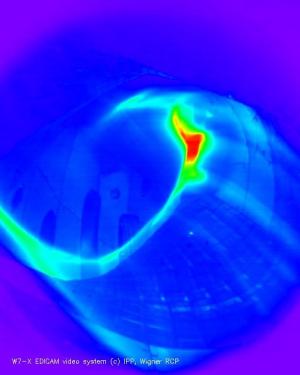Fusion world
Wendelstein 7-X resumes operation
11 Sep 2017
-
Isabella Milch, Max Planck Institut for Plasma Physics
The Wendelstein 7-X stellarator is up and running again, following a shutdown phase dedicated to equipping the machine for longer discharges and higher heating power.
A plasma discharge in the upgraded Wendelstein 7-X stellarator — not your usual D-shaped tokamak plasma... Photo: IPP/Wigner RCP (coloured black-and-white photo)
The world's largest fusion device of the stellarator type is back in action. Plasma experiments have resumed after a 15-month shutdown phase, during which over 8,000 graphite wall tiles and ten divertor modules were installed in the plasma vessel. This high-tech cladding that will protect the vessel walls and allow higher temperatures and plasma discharges lasting 10 seconds.
The geometry of the new divertor, with plasma-facing tiles that conform exactly to the twisting contour of the plasma edge, is considered power plant relevant for the first time—particularly in the ratio of the divertor area to the plasma volume.
"We are therefore very excited that we are now able to investigate whether the divertor concept of an optimized stellarator can really work properly," says Project Head Professor Thomas Klinger.
All ten microwave transmitters of the microwave heating system have been brought on line, which will permit higher density and higher temperature plasmas and lead possibly to the enhanced thermal insulation of the plasma in the optimized device. New diagnostic instruments will also allow the observation of plasma turbulence for the first time.
The goal of the Wendelstein 7-X project is to investigate the suitability of the stellarator type of fusion device for a continuous-operation fusion power plant. Following the conclusion of main assembly in 2014 at the Max Planck Institute for Plasma Physics (IPP) in Greifswald, Germany, the machine achieved its first helium plasma in December 2015 and its first hydrogen plasma in February 2016.
Read the full press release on the IPP website.


